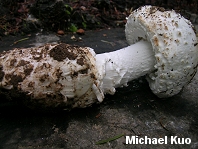| Major Groups > Gilled Mushrooms > Pale-Spored > Amanita > Amanita smithiana |

|
Amanita smithiana [ Basidiomycetes > Agaricales > Amanitaceae > Amanita . . . ] by Michael Kuo In dry weather, the West Coast's Amanita smithiana is fairly easily distinguished from all but its closest look-alikes, since it features a covering of thin, soft universal veil powder on its cap. The problem is that in rainy conditions, the soft universal veil material can be washed away. Since Amanita smithiana is a fairly common mushroom in the conifer woods of the Pacific Northwest, it can be mistaken, in its smooth-capped state, for the matsutake, Tricholoma murrillianum. Experienced mushroom hunters are not likely to mistake Amanita smithiana for a matsutake, but may still find it difficult to identify with precision, since it belongs to Section Lepidella of Amanita, a notoriously difficult identification area. Fortunately, "Lepidellas" are not as abundant in the Pacific Northwest as they are in the southeastern United States, and the closest look-alike is probably Amanita silvicola, which usually lacks the rooting stem base of Amanita smithiana, and has much skinnier spores (measuring 7-10 x 4-6 µ). Thanks to University of California Herbarium for facilitating my study of the collection cited and described below. Description: Ecology: Mycorrhizal with conifers, especially Douglas-fir; often reported in the vicinity of decaying wood; fall and winter; distributed from the Pacific Northwest to central California. Cap: 5-17 cm; convex to planoconvex; whitish (sometimes faintly brownish in dry weather); covered with soft, powdery universal veil material, or occasionally with whitish warts; sometimes becoming bald when washed by rains. Gills: When young covered by a white, powdery partial veil; free from the stem; close or crowded; whitish; with frequent short-gills. Stem: 6-18 cm long; up to 3.5 cm thick; spindle-shaped when uprooted and viewed in its entirety; the base swollen and extending into a root-like projection; shaggy when young and fresh; with a ragged, frequently torn or missing ring; with whitish universal veil fragments in concentric zones at the top of the bulb. Flesh: White; unchanging when sliced. Odor: Unpleasant in some collections; not distinctive in others (especially when collected in young stages). Spore Print: White. Chemical Reactions: KOH negative on all surfaces. Microscopic Features: Spores 8.5-12 x 6-8 µ; ellipsoid; smooth; amyloid. Basidia 4-spored; clamped. Pileipellis a cutis of elements 1-9 µ wide. Lamellar trama bilateral; subhymenium ramose. REFERENCES: Bas, 1969. (Smith, Smith & Weber, 1979; Thiers, 1982; Jenkins, 1986; Lincoff, 1992; Tulloss & Lindgren, 1992; .) Herb. UC 1860217 (DeShazer 600). This site contains no information about the edibility or toxicity of mushrooms. |
© MushroomExpert.Com |
|
Cite this page as: Kuo, M. (2013, July). Amanita smithiana. Retrieved from the MushroomExpert.Com Web site: http://www.mushroomexpert.com/amanita_smithiana.html |
